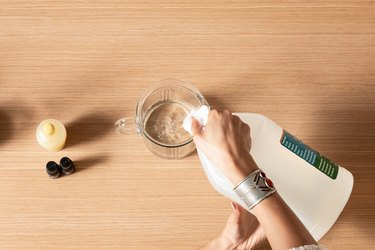A natural acid, distilled white vinegar can do some pretty amazing things around the house in addition to adding tang to your salad dressing. One of its many tricks is helping to remove dried paint stains on wood and other household surfaces. Vinegar is safer than chemicals, and despite its own pungent odor, it often smells better as well. Here's the scoop on using vinegar for dried paint removal.
What Vinegar Can and Can't Do
Video of the Day
Vinegar is pretty amazing, but it's not magic in a bottle. It can help to loosen dried paint spills and drips, but it only softens the paint — it doesn't dissolve or remove it. Even with the help of vinegar, you may need a paint scraper or scrub brush to completely eliminate paint stains. Note too that vinegar works best on fresh paint problems. It probably won't help much or at all on fully cured paint.
Video of the Day
Even when vinegar works like a charm, it's best for small jobs. It's not really a good option if you need to strip an entire door or a larger surface. You can give it a try if you're patient, dedicated to a chemical-free job, or really hate sanding, but stripping and sanding are likely to be much faster options for bigger jobs.
How to Remove Paint With Vinegar
Fortunately, you don't need any fancy equipment to try removing paint with vinegar. You should already have most if not everything you need on hand, especially if you're in the midst of a painting project.
- Place some vinegar in a saucepan and heat it on the stove, removing it from the heat just before it begins to boil. You can also heat the vinegar in your microwave.
- Use a paintbrush to paint the warm vinegar onto the paint stain you wish to remove. Allow the vinegar to sit on the stain for 10 to 15 minutes.
- Use a scrub brush or paint scraper to remove the softened paint. Work the scrub brush in a circular motion. If using a scraper, do so carefully to make sure you scrape the surface without gouging it.
- Rinse the area with warm water.
If Vinegar Fails
Given its safe, nontoxic nature, vinegar is a terrific first step for your paint-removal efforts. If it doesn't work, however, you may need to step up your efforts. Vegetable oil can also soften paint and may be worth a try, but it is often unlikely to succeed where vinegar fails. Acetone can be a great next step if the paint is on a nonporous surface. Use caution on plastic, though, as acetone can melt certain plastics. Test the acetone in a discrete area before you go crazy with it.
When all else fails, it's time to concede the match and reach for a commercial paint stripper. Typically, you'll apply the stripper, leave it to sit on the surface for a few minutes, and then scrape off the paint with a scraper. On cement, the stripper may need up to an hour to work and will need to be removed with a stiff brush rather than a paint scraper.
